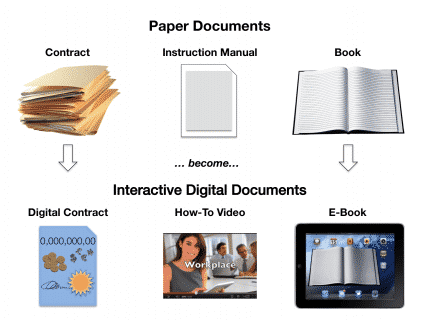The Changing Role of the Document: The Paper Era is coming to an End
Authors: Jim Lundy, Mike Anderson Date: May 18, 2012
Topics: Content Management Research Note Number: 2012-11
Issues:
What trends are impacting content and how it is managed?
How will content management technologies and architectures evolve?
Summary: The era of paper-based documents is beginning to wind down. Documents are still the way business is transacted, but with the rise of tablets, video and interactivity, their nature is changing to meet the changing appetites of users and how they communicate.
The role of the document in the enterprise is changing (see Note 1). While “documents,” generically speaking, are still the currency by which business is transacted, the nature and content of those documents are changing, shifting from text on paper to more of a rich media approach. The traditional text document is giving rise to rich media content that is contextual and semantic in nature. This Research Note looks at where documents are going in usage and how enterprises should start to look at how they use documents.
In the last 25 years, the tools people use to create content at work have changed very little. Editors are basically what they were a few years back with some exceptions. Editing a text document in Word has not fundamentally changed.
Paper versus Electronic
Paper is one of mankind’s oldest display media, and it is still one of the best. People will print less as display quality improves (e.g., Apple’s Retina Display) and as mobile devices offer more user-friendly alternatives, but many users still have an instinctive urge to print documents. As content becomes more interactive, however, printing a document will reduce its functionality to the point where it becomes impractical.
At the same time, printing a document incurs costs (ink and toner) and provides fewer benefits than ever. The visual quality of modern high-end screens approaches that of paper. Mobile devices, particularly tablets, make electronic documents much easier to access and use. The tablet, with its 8-10 hour battery life, is an ideal display source for electronic documents. Having those documents available on the device and also backed up in a content management repository makes it much easier to keep the content accurate and current. For mission-critical content like an airline flight checklist, that alone would justify the cost of an all-electronic document infrastructure. But every user can benefit from features like desktop sync, which manages versions, bookmarks and comments across multiple devices and venues (e.g., home, car, client office, etc.).
For all these reasons, the value proposition for paper documents is beginning to diminish. In particular, users are beginning to see the unnecessary cost and risk of moving back and forth between a digital document and multiple paper instances – not all of which may be identical, accurate or current, and none of which retain the real-time interactivity of the digital version (see Figure 1)

Note: This is part of Aragon’s archived research. Please visit our Coverage Areas page to view our most recent content.
Copyright © 2012 Aragon Research Inc. and or its affiliates. All rights reserved.
